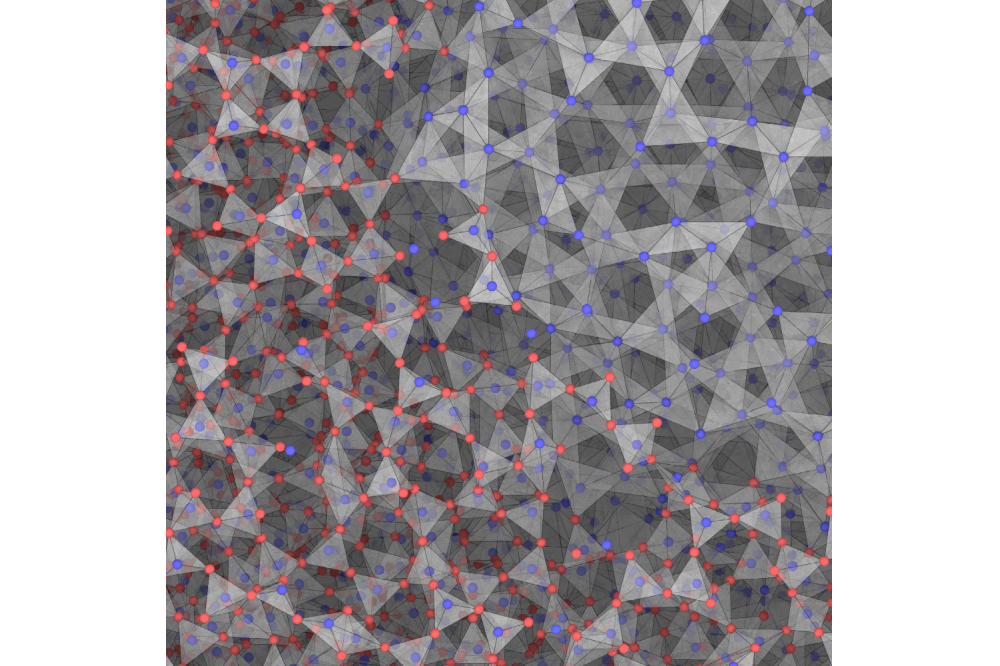A Machine-Learning Interatomic Potential for the Si-O System
Einleitung
Nowadays, atomistic simulations are becoming more and more important. Due to the increasing availability of computational time, large systems with several million atoms are accessible for classical molecular dynamics simulations. However, for molecular dynamics simulations, it is necessary to use an interatomic potential for force and energy calculations. These interatomic potentials are often tailored only to specific structures and are not transferable to other phases. For more complex phase transitions, classical interatomic potentials are often too inaccurate. This is especially important for materials such as silica, which has numerous crystalline polymorphs and an important amorphous phase. One way to increase accuracy would be to use quantum mechanical methods such as density functional theory. The problem with these methods is that the system size is limited to up to a thousand atoms. To overcome this problem, we have fitted an interatomic potential based on machine learning techniques for amorphous and crystalline silica. This machine-learning potential is several orders of magnitude faster than quantum mechanical calculations, and therefore allows simulations of hundreds of thousands of atoms with near quantum mechanical accuracy.
Methoden
In this project, we calculated energies and forces using density functional theory calculations within the Vienna Ab initio Simulation Package (VASP). In density functional theory, the Kohn-Sham equations are solved. To approximate the exchange-correlation energy, we use the Strongly Constrained and Appropriately Normed (SCAN) functional. The calculated energies and forces were used to fit interatomic potentials using the QUantum mechanics and Interatomic Potentials (QUIP) and Machine Learning Interatomic Potentials (MLIP) codes. These potentials use Gaussian process regression or linear regression as the machine learning algorithm. Smooth overlap of atomic orbitals (SOAP) and moment tensors were used as descriptors. An active learning method is also implemented in the MLIP library to automatically detect structures with a large error. This method uses the maxvol algorithm. For the molecular dynamics simulations, we used the Large-scale Atomic/Molecular Massively Parallel Simulator (LAMMPS) code.
Ergebnisse
In this project period, the general goal was to improve the existing potential and corresponding database from the previous project period. First, we recalculated the entire existing database using a different exchange-correlation functional. The problem with the previously used PBEsol functional is that it does not adequately describe the thermodynamics of silica. In contrast, the SCAN exchange correlation functional now used allows for an interatomic potential that describes the phase transitions between multiple silica polymorphs in good agreement with experimental results. The recalculated database was extended to include more amorphous and liquid structures by further melt-quench iterations. In addition, defect structures such as point defects and surfaces were added to the database. Finally, the configuration space in the training database was expanded from pure silica to silica-silicon mixtures. By adding more data for mixed states using active learning, we created a comprehensive database for mixed silicon and silica structures. Using the potential trained with this database, we can observe clear phase separation between silicon and silica in mixed liquid systems and build promising structural models for the amorphous-amorphous interface.
Diskussion
The results show that it is possible to generate a machine-learned interatomic potential capable of simultaneously and accurately describing a wide range of different structures. In particular, the accurate modeling of silicon and silicon dioxide enabled by the new potential allows simulations for a variety of problems, such as structural modeling of silicon monoxide, silicon and amorphous silicon dioxide interfaces in semiconductor devices, and oxidized silicon nanoparticles. However, there are still some unanswered questions. In this project, we have used various machine learning approaches, but it is not entirely clear whether there is a better, more efficient, and more accurate approach.
Ausblick
Since there are many related materials such as silicon oxycarbide and silicon monoxide that are promising for battery applications, it will be interesting to extend the potential to lithium and carbon.




